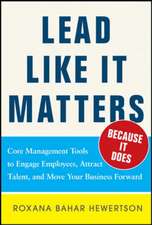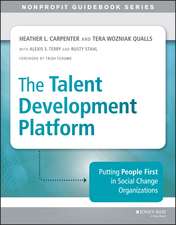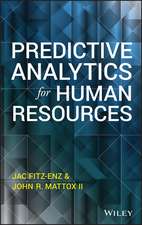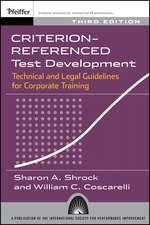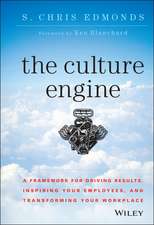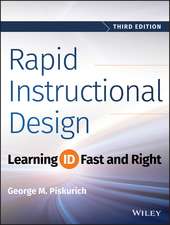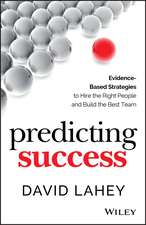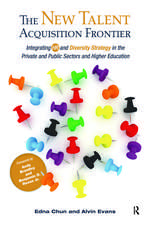Contingent Academic Labor: Evaluating Conditions to Improve Student Outcomes
Autor Daniel B. Davisen Limba Engleză Hardback – 5 oct 2017
| Toate formatele și edițiile | Preț | Express |
|---|---|---|
| Paperback (1) | 226.50 lei 6-8 săpt. | |
| Taylor & Francis – 2 oct 2017 | 226.50 lei 6-8 săpt. | |
| Hardback (1) | 996.48 lei 6-8 săpt. | |
| Taylor & Francis – 5 oct 2017 | 996.48 lei 6-8 săpt. |
Preț: 996.48 lei
Preț vechi: 1215.22 lei
-18% Nou
Puncte Express: 1495
Preț estimativ în valută:
190.70€ • 198.36$ • 157.43£
190.70€ • 198.36$ • 157.43£
Carte tipărită la comandă
Livrare economică 14-28 aprilie
Preluare comenzi: 021 569.72.76
Specificații
ISBN-13: 9781620362518
ISBN-10: 1620362511
Pagini: 136
Dimensiuni: 152 x 229 mm
Greutate: 0.34 kg
Ediția:1
Editura: Taylor & Francis
Colecția Routledge
Locul publicării:Oxford, United Kingdom
ISBN-10: 1620362511
Pagini: 136
Dimensiuni: 152 x 229 mm
Greutate: 0.34 kg
Ediția:1
Editura: Taylor & Francis
Colecția Routledge
Locul publicării:Oxford, United Kingdom
Public țintă
Postgraduate and Professional Practice & DevelopmentNotă biografică
Daniel B. Davis is a PhD candidate in sociology at the University of California, San Diego; a Kauffman Foundation Dissertation Fellow; half-time faculty at Point Loma Nazarene University and a lecturer at San Diego State University. He has published articles on student college-to-career pathways in Sociology of Education and Research in the Sociology of Organizations. Davis previously researched undergraduate educational outcomes with CREATE (The Center for Research on Educational Equity, Assessment and Teaching Excellence) at UC San Diego. He has taught dozens of college courses in various settings, including private and public, community colleges and four-year universities, online and face-to-face. Across these institutions, the range of working and learning conditions Davis encountered was vast, with the highest-paying campus offering compensation four times greater than the lowest-paying institution. Some of the positions had benefits and reasonable security of contract; others had neither. The sense of professional inclusion—through designated office space, invitations to department events, and more—was substantial at certain campuses and non-existent at others. It was the experience of these disparate working conditions, their impact on Davis’ sense of professional engagement, and their effect on his students that motivated him to write this guide. Click here to visit Daniel's professional website. Adrianna Kezar is a professor of higher education at the University of Southern California and codirector of the Pullias Center for Higher Education. Kezar is a national expert of student success, equity and diversity, the changing faculty, change, governance, and leadership in higher education. Kezar is well published with 18 books and monographs, more than 100 journal articles, and more than 100 book chapters and reports. Recent books include Envisioning the Faculty of the 21st Century (Rutgers University Press, 2016), How Colleges Change (Routledge, 2013
Cuprins
Introduction Part I. Contingent Academic Labor in Broader Contexts 1. Contingent Faculty amid National Labor Trends 2. The Influence of Contingent Faculty on Student Outcomes 3. The “Cooling-Out Function” on Contingent Faculty Part II. Illustrating the Range of Work Conditions 4. Material Equity. Pay Parity, Job Security, and Benefits 5. Professional Equity. Opportunities for Development and Advancement 6. Social Equity. Faculty Diversity and Inclusivity by Race and Gender Part III. The Contingent Labor Conditions Scorecard 7. Introducing the Contingent Labor Conditions (CLC. Scorecard 8. Calculating the Contingent Labor Conditions (CLC. Scorecard Conclusion References Appendix. Contingent Labor Conditions (CLC. Scorecard Blank Forms
Recenzii
"In this book, Daniel B. Davis has proposed an important practical tool for addressing the contingent faculty crisis and ensuring that all stakeholders participate in the transformation of higher education into a site of authentic excellence, and commitment to equity and equality."
From the Foreword:
“This book, in my estimation, is one of the most important books focused on contingent faculty in higher education…I highly recommend this book to leaders within unions, academic administrators, faculty leaders - both tenure-track and contingent - as THE approach for advancing equity on college campuses.”
Adrianna Kezar, PhD, Professor, USC, Co-director Pullias Center and Director Delphi Project
"Contingent Academic Labor by Daniel Davis is a timely, relevant, and necessary text that pushes us all to reconsider the treatment of non-tenure track academic faculty and the implications this treatment has for students. The book is an organized and concise work targeted at all who are (or should be) concerned with the treatment of contingent faculty: faculty, students, administrators, researchers, labor unions, etc. This work builds off of successful tools geared toward advancing equity in higher education like the Equity Scorecard (Bensimon, Hao, Bustillos, 2006) and offers a useful gauge for campus stakeholders to take the temperature regarding contingent faculty treatment and experiences in higher education.
In the introduction, Davis sets the stage for the present conditions contingent faculty face working in a higher education environment that underpays, undervalues, and under-employs them. Despite the growing number of contingent faculty members, their treatment indicates higher education has taken for granted their import to student success. Davis divides the book into three parts so that the reader first has a foundation of the broader context and conditions of academic labor. He then depicts the variety of working conditions for contingent faculty and ends with an overview of the utility of the Labor Conditions Score developed to aid higher education institutions in assessing the environments in which their contingent faculty work.
It is clear that no one wins with the present treatment of contingent faculty members. One participant interviewed for this work said, 'I don’t understand why this situation persists when it’s a lose-lose-lose scenario. There has to be a better way' (p. 22). When the faculty members are struggling to survive, they oftentimes cannot recognize or address the challenges students face. The use of a tool like the Contingent Labor Conditions Scorecard can help move institutions towards maximizing student experiences and outcomes. The tool can also help better assess the feelings of contingent faculty members in their current roles. The text will certainly prompt additional discussion and direct attention to this important topic of contingent faculty, and hopefully those who read it will push for institutions to convert the knowledge shared into meaningful actions that will benefit all campus stakeholders."
Teachers College Record
“Daniel Davis got the single most important thing about current contingent faculty right (besides their extreme exploitation, of course), which is that most of us would rather be full-time, job-secure (tenured or otherwise) faculty. It is amazing how many writers get that wrong. One could hope that most of the book’s cogent prescriptions for change will not be ignored by the vast majority of the intended audience: administrators and trustees. The rest of us with a stake in higher education cannot afford to ignore this book and its very reasonable ideas for change. I look forward to his next book about how to get there.”
Joe T. Berry, author of Reclaiming the Ivory Tower: Organizing adjuncts to change higher education. (Monthly Review Press, 2005) and editor of the weekly news aggregator COCAL UPDATES for contiongent
“Provides a tool that institutions and/or advocates can use to spur and guide reform. For readers new to conversations about contingent faculty, [this] is a good place to start – but it is not just for beginners. This book’s synthesis of recent work in the field is useful for anyone interested in understanding and evaluating local campus conditions. For starters, institutions should care about the working conditions of their contingent faculty because of their impact on students.”
Change: The Magazine of Higher Learning
From the Foreword:
“This book, in my estimation, is one of the most important books focused on contingent faculty in higher education…I highly recommend this book to leaders within unions, academic administrators, faculty leaders - both tenure-track and contingent - as THE approach for advancing equity on college campuses.”
Adrianna Kezar, PhD, Professor, USC, Co-director Pullias Center and Director Delphi Project
"Contingent Academic Labor by Daniel Davis is a timely, relevant, and necessary text that pushes us all to reconsider the treatment of non-tenure track academic faculty and the implications this treatment has for students. The book is an organized and concise work targeted at all who are (or should be) concerned with the treatment of contingent faculty: faculty, students, administrators, researchers, labor unions, etc. This work builds off of successful tools geared toward advancing equity in higher education like the Equity Scorecard (Bensimon, Hao, Bustillos, 2006) and offers a useful gauge for campus stakeholders to take the temperature regarding contingent faculty treatment and experiences in higher education.
In the introduction, Davis sets the stage for the present conditions contingent faculty face working in a higher education environment that underpays, undervalues, and under-employs them. Despite the growing number of contingent faculty members, their treatment indicates higher education has taken for granted their import to student success. Davis divides the book into three parts so that the reader first has a foundation of the broader context and conditions of academic labor. He then depicts the variety of working conditions for contingent faculty and ends with an overview of the utility of the Labor Conditions Score developed to aid higher education institutions in assessing the environments in which their contingent faculty work.
It is clear that no one wins with the present treatment of contingent faculty members. One participant interviewed for this work said, 'I don’t understand why this situation persists when it’s a lose-lose-lose scenario. There has to be a better way' (p. 22). When the faculty members are struggling to survive, they oftentimes cannot recognize or address the challenges students face. The use of a tool like the Contingent Labor Conditions Scorecard can help move institutions towards maximizing student experiences and outcomes. The tool can also help better assess the feelings of contingent faculty members in their current roles. The text will certainly prompt additional discussion and direct attention to this important topic of contingent faculty, and hopefully those who read it will push for institutions to convert the knowledge shared into meaningful actions that will benefit all campus stakeholders."
Teachers College Record
“Daniel Davis got the single most important thing about current contingent faculty right (besides their extreme exploitation, of course), which is that most of us would rather be full-time, job-secure (tenured or otherwise) faculty. It is amazing how many writers get that wrong. One could hope that most of the book’s cogent prescriptions for change will not be ignored by the vast majority of the intended audience: administrators and trustees. The rest of us with a stake in higher education cannot afford to ignore this book and its very reasonable ideas for change. I look forward to his next book about how to get there.”
Joe T. Berry, author of Reclaiming the Ivory Tower: Organizing adjuncts to change higher education. (Monthly Review Press, 2005) and editor of the weekly news aggregator COCAL UPDATES for contiongent
“Provides a tool that institutions and/or advocates can use to spur and guide reform. For readers new to conversations about contingent faculty, [this] is a good place to start – but it is not just for beginners. This book’s synthesis of recent work in the field is useful for anyone interested in understanding and evaluating local campus conditions. For starters, institutions should care about the working conditions of their contingent faculty because of their impact on students.”
Change: The Magazine of Higher Learning
Descriere
This book will be useful for administrators and labor organizers alike in assessing the degree of exploitation, or empowerment, in their own institution.

